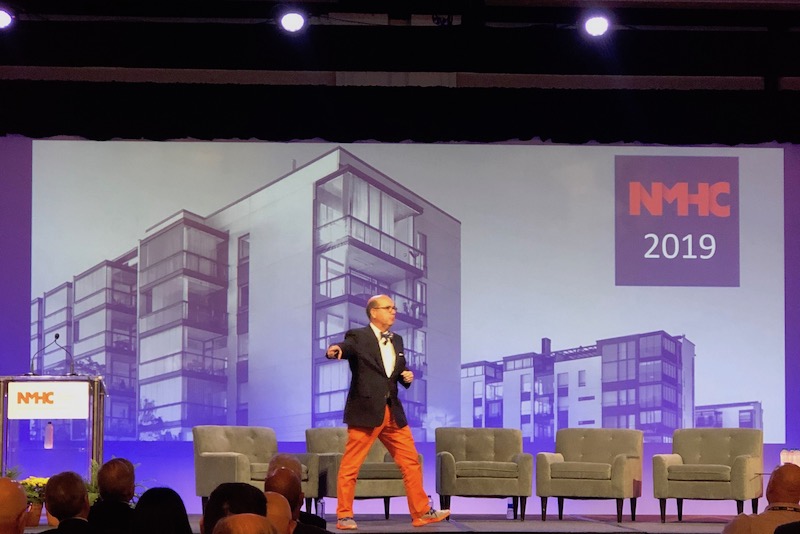Demography Set to Be the Next Disruptor for Multifamily

Technology is often talked about as the biggest disruptor facing the multifamily industry, but demographic changes could have an even greater impact on the housing market, according to Joseph Coughlin, director of the AgeLab at the Massachusetts Institute of Technology.
Speaking at the National Multifamily Housing Council’s 2019 Apartment Strategies Outlook Conference, Coughlin discussed how population shifts and changing generational behaviors could significantly alter the dynamics of the apartment sector.
The Changing Makeup of the Population
With people living longer than ever before and not having as many children as in past decades, the U.S. population is increasingly aging. In fact, one American turns 73 every seven seconds, Coughlin noted.
“By 2047, there will be more people over the age of 60 on the planet than children under the age of 15,” he added.
These older adults also have new preferences, including the desire to have active lifestyles and age in place. Those that choose to downsize, or have to out of necessity, are increasingly moving into multifamily buildings, boosting rental demand in recent years.
They’re also often looking for walkable communities with access to amenities. Unlike many of their Millennial counterparts who have flocked to urban downtown areas, the older generation is moving to smaller, urban-like cities, including college towns like Ann Arbor, Michigan, which are connected to transportation and a variety of restaurants and shopping.
Many in the Baby Boomer and Senior Age segment are also living alone, which is the fastest-growing renter segment, Coughlin noted. In the U.S., 27% of households only consist of one person.
Millennials Delaying Adulthood
Millennials’ unique behaviors are also contributing to the overall aging population. Their lifestyle choices are different than those of their predecessors, with many delaying the typical life stages of marriage, homeownership and having children.
Due to financial constraints or personal lifestyle choices, many Millennials don’t own a home, which has contributed to the apartment market’s stellar performance and the homeownership rate hitting historical lows during this economic cycle.
However, there has been some reversal in the attitudes of Millennials towards owning a home. The rate has slowly increased from 35.6% in the third quarter of 2017 to 36.8% in the third quarter of 2018, according to the U.S. Census Bureau. It will be interesting to see how the rentership and homeownership rates trend in the coming years.
Millennials also differ from their predecessors in their decisions to have a family. The average age to marry for women is 27.4 and 29.5 for men, compared to 20.3 years for women and 22.8 for men in 1960, according to the Pew Research Center. Only two in five Millennials were married in 2015, compared to two in three in 1980.
In terms of having children, while parents of Baby Boomers averaged 3.8 children per household — hence the creation of the Baby Boomer generation — and Baby Boomers averaged about 2.0 children per household, Millennials are looking closer to 1.7 per household. Today, one in five women are childless, and the new births that are happening are largely from women age 35 and older, Coughlin reported.
Integration of Work and Life
Another major shift we’re seeing in today’s society is the evolution of the workplace. There are currently five generations in the labor market, Coughlin noted, as older adults are retiring later. This is posing a challenge for employers to offer a work environment that meets everyone’s needs.
Millennials have been a disruptor for the traditional office space. They have pushed back against the traditional cubicle-style office layouts. Instead, they are calling for more flexible workspaces and the ability to work remotely. While much discussion used to be around work-life balance, the Millennial generation largely doesn’t distinguish between work and play, introducing the concept of “work-life integration,” Coughlin said.
This preference has carried over to the apartment market and contributed to its rebound after the recession, as many multifamily developers and owners have found success in creating live-work-play communities.
But multifamily owners will have to innovate and partner with technology companies to offer the connectivity young renters want. Coughlin noted that by 2022, a typical household could have more than 500 smart devices, according to a Gartner report.
It remains to be seen exactly how all of these factors will impact the multifamily market, but it’s clear that changing preferences and the makeup of the U.S. population will lead to significant shifts in the way multifamily stakeholders build, invest in and manage apartment communities.

